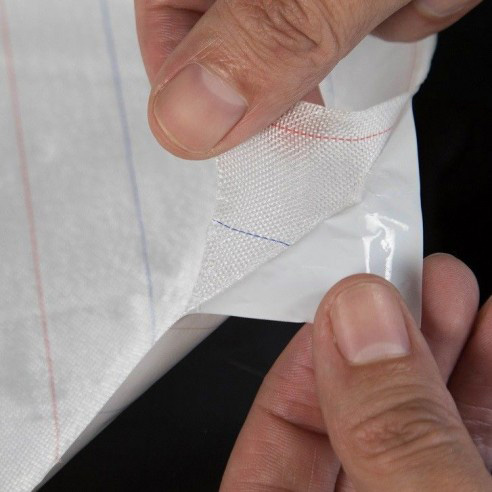Peel ply is widely used in the vacuum forming process of saturated resin and unsaturated resin. In this article, I will introduce what is peel ply, the characteristics and application of peel ply and how to use it.
1. What is peel ply
Peel ply is a synthetic woven fabric which composes of nylon, glass or other synthetic materials with blue or red tracer lines. Peel ply is made by coating a glass cloth with PTFE (polytetrafluoroethylene) on one side and PSA (pressure-sensitive adhesive) on the other side, scouring and heat setting.
It is often used as an auxiliary layer in the curing process and is placed between the mold and the workblank parts to prevent the resin from sticking to the mold. It can be used directly against the laminate to help seal the surface and allow the resin to thoroughly cure. After the curing is completed, the peel ply will be peeled off without leaving sticky uncured resin and creates a smooth surface.
The common types of peel ply are PET peel ply, Nylon peel ply, Teflon peel ply, etc.

2. Characteristics of peel ply
Peel plies should be stored in a ventilated, dry and clean warehouse in order. Otherwise, they will deform or be damaged under press. Besides, peel plies should be stored not less than 2 meters away from the heat source and no more than 2 years.
The main characteristics of peel plies are:
Peel ply can withstand from a low temperature -196℃ to a high temperature 350℃. It is weather-resistant and anti-aging. It has been proved that the strength and the weight of the stripper cloth will not decrease when it is placed continuously at a high temperature of 250℃ for 200 days. Likewise,it will not crack under the ultra-low temperature of -180℃, and still keeps the original softness.
Peel ply is non-adhesion: It is not easy to adhere to any material. Also easy to clean all kinds of oil stains, stains or other attachments attached to its surface. Paste, resin, paint and almost all adhesive materials can be easily removed;
Peel ply is resistant to chemical corrosion, strong acid, alkali and various organic solvents corrosion.
Peel ply has a low friction coefficient around 0.05 to 0.1, which is the best choice for oil-free self-lubrication.
The light transmittance of peel ply reaches 6%-13 %.
Peel ply has high insulation performance, UV protection and is anti-static.
The peel ply has good dimensional stability, high strength and good mechanical properties.
Peel ply has resistance to drugs and no toxicity. It can withstand almost all potions.
Peel ply is fire retardant.
3. Application of peel ply
Peel plies are generally applied in anti-stick lining, gasket and conveyor belt. According to the different thicknesses, peel plies will be used for various conveyor belts, adhesive belts, sealing belts, etc of drying machinery.
Textile printing and dyeing——Reticular fiber transport guide tape applied in bleaching and dyeing fabric drying, printing drying, fabric shrinkage drying, non-woven fabric drying, etc.
Silkscreen printing——Reticular fiber transport guide tape applied in UV drying, plastic screen printing and drying, paper oiling and drying.
Comprehensive items——Drying house guide tape applied in food freezing and thawing, baking, heat shrinkage of packaged goods.
Other cases——Reticular fiber transport guide tape applied where hot air drying is required and hot processing transmission conditions.
4. How to use peel ply
1) Before using peel ply, make sure the laminate is fully saturated with a glossy surface and a bit of extra resin inside.
2) Lay out the fiberglass to the surface with epoxy and a plastic squeegee, add and smooth out the peel ply after the surface is wetted out and the fiberglass has been clear.
3) Smooth the peel ply and you will find the surface reaches a uniformly dull sheen without air bubbles or dry spots.
4) Wait until the surface is 100% cured, then simply tear off the peel ply to have the next layer of epoxy.